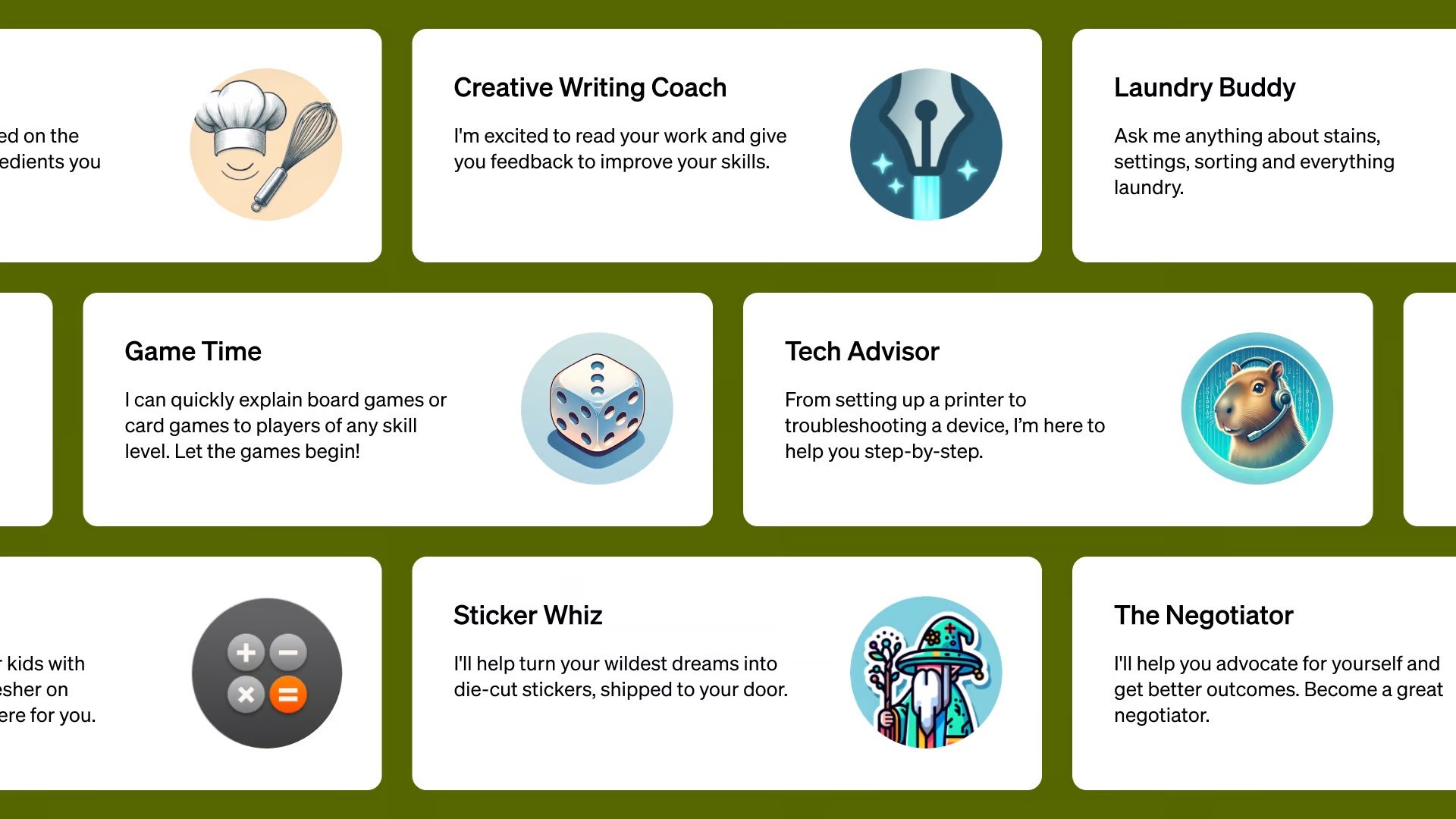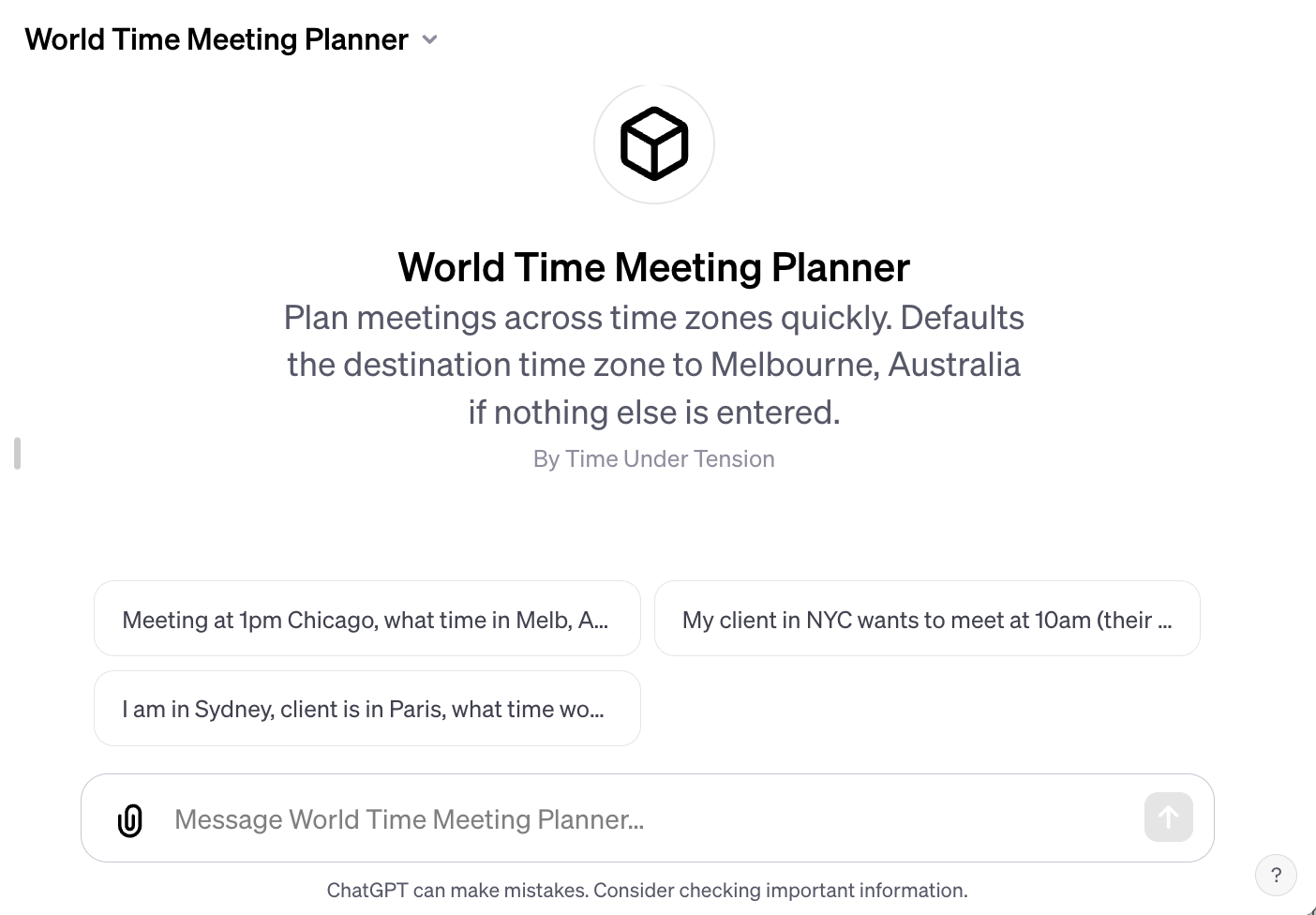GPTs - nascent products, or no-code toys?
Since the launch of “GPTs” by OpenAI at their DevDay in early November, they have caught the imagination of the world, with tens of thousands being created in the past month.
Not to be confused with OpenAI’s Large Language Models which are (unhelpfully) also called GPT-4 etc, these GPTs can be easily built with a no-code tool provided inside of ChatGPT, for those lucky enough to have a Plus subscription.
Per the OpenAI site, with GPTs “You can now create custom versions of ChatGPT that combine instructions, extra knowledge, and any combination of skills.”
GPTs as products
OpenAI plan to release a GPTs Store in early 2024, which promises to not only provide an easy way for others to discover your GPT, but also for you to create pay-per-use GPTs and make money from your creations.
This suggests that they see GPTs as real products (or apps), rather than quick experimental demos.
Image from OpenAI's web site, with example GPTs
Introducing World Time Meeting Planner
Over the weekend I was experimenting with creating my own GPTs, and I built the World Time Meeting Planner, a chat tool for planning meetings with people in other timezones. It's really helpful.
You can try it out here: https://chat.openai.com/g/g-WGGgcQnUV-world-time-meeting-planner
Screenshot of the World Time Meeting Planner GPT I built
Unlike most boring timezone convertors, using the magic of generative AI it even creates a customised Zoom background for your meeting 🤩
Image generated for a 7am meeting with someone in Paris
I shared it with some friends and received some really positive feedback, with several bookmarking it to use during their working week. Have I stumbled upon the next instagram or WhatsApp viral smash app?!
Getting excited, I found a great .ai domain name and was about to buy it when I got to thinking whether World Time Meeting Planner (WTMP) is potentially a real product, or simply a no-code toy?
The key aspects of building a hit digital product are well known, and below I have interrogated these through the lens of what is currently possible with OpenAI no-code GPTs.
Once again, for clarity, I am not talking about GPT-4 and custom apps or Assistants built using OpenAI APIs, only the no-code “GPTs” that are freely available to ChatGPT Plus users.
Secrets to digital product start-up success
Market size 👎 - ideally your product appeals to a wide audience, and is also available to that audience. In what I think is the single biggest limitation, the audience size for GPTs is severely constrained, as they are only available to ChatGPT Plus (paid) subscribers.
This is a very small percentage of overall ChatGPT subscribers, and as of the time of writing OpenAI are not allowing any new paid subscribers! Yes, you read that correctly, due to high demand OpenAI have temporarily paused any new Plus subscriptions. So on market size, GPTs currently get an F.
Distribution 👍 - early in 2024 OpenAI plan to release a GPT Store, making WTMP more findable by ChatGPT users. Hopefully they do a better job with this than they did with their Plug-in store, which has a woefully bad UX.
This is a positive, as every GPT will soon be discoverable from within ChatGPT. I give it a B+ with some optimism that the Store has good search functionality, and the ability to rate & review GPTs.
Virality 👎- many of the very popular products and apps we use have some kind of inbuilt virality, in that a byproduct of using the app is sharing it with others. There is nothing like this available (or possible) within GPTs, and it’s hard to imagine this changing. On a slightly different topic, there are also no network-effects. A custom GPT doesn’t get better if I get my friends to use it. On virality and network-effects I give GPTs an F.
Monetisation 👍 - it might be too early to think about how I capitalise on the inevitable runaway success of WTMP, but thankfully this should be easy with the GPT Store. I don’t know yet what the options or methods of monetisation will be, but whatever they are it should be extremely easy to set-up. And the users (ChatGPT Plus subscribers) already have their credit-cards on file with OpenAI, so purchasing should be frictionless. I give monetisation it a (tentative) A-
Iterations, test & learn 👎- critically important for any digital product start-up is the ability to quickly release experiments, to see what works and to make iterations. This relies on being able to have tracking, analytics and user feedback. None of these are possible within GPTs. You cannot add tracking code. You cannot see the user chat history. You don’t even get basic analytics on if your GPT is popular or not! This is a big fat F from me.
Moats 👎- before I take WTMP to A16Z with my hand out for some Venture Capital, I need a good story about defensibility, what is my “moat”? Sadly, not only is it easy for someone to copy my GPTs (the ease of creation being a blessing and a curse), but it’s also been shown to be quite easy to a) download and save my knowledge data, and b) have GPTs spell out their Configuration Instructions. Basically, someone can easily download the ‘source code’ of my custom GPT and make their own in a few minutes. Ouch. On the scorecard for Moats I give GPTs the lowest possible score of an F-
So what’s next for World Time Meeting Planner?
In my opinion, with the current incarnation (and bearing in mind they are only a month old) trying to build a digital product using no-code GPTs is like building on quick-sand.
Most of the keys to building a successful digital product are impossible or impractical with no-code GPTs, and it makes me wonder why OpenAI are building a GPT Store in the first place. The Apple App Store model is incredibly successful, as iOS developers have nearly complete control over their apps and as a result can build in virality, test & learn and have a moat.
In the absence of this control, GPTs are (for now) destined to be no-code toys. As an unashamedly OpenAI fan, I hope that I am proven wrong.
The alternatives to GPTs are either to use a no-code tool that has more flexibility, such as MyAskAI, or to custom build an app using Large Language Models via an API (such as we are doing for many Time Under Tension clients).
If you would like more information about how to custom build a generative AI app, or would like to invest in the World Time Meeting Planner ( 🙂), please get in touch with Time Under Tension.



